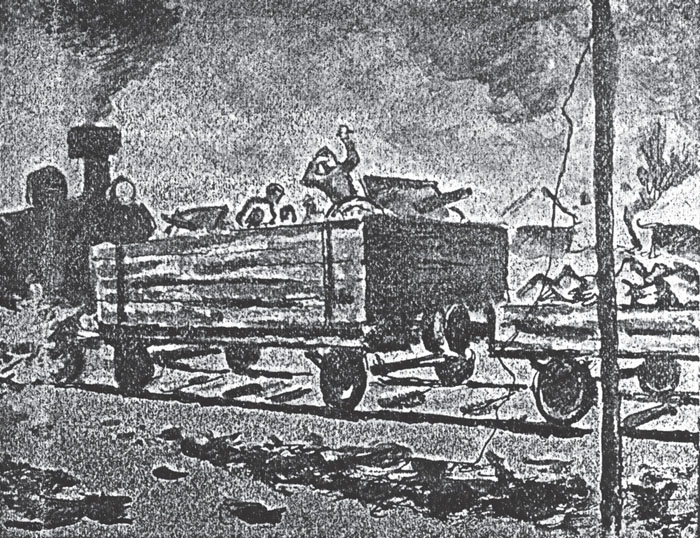
The history of the Ukraine is complex, and requires a brief introduction in order to be able to understand the tortuous story of its armoured trains.
The territory of the Ukraine was fought over first by Germany and Austria-Hungary, then by the nations and various factions which were born or profited from the dismantling of the Russian and Austro-Hungarian Empires: Poland, Romania, Bolshevik Russia, Red Ukrainians, Nationalist Ukrainians, the White Russians, the Anarchist Black Army of Makhno, independent Cossacks and assorted atamans (warlords).
The Ukraine (less Galicia and the Crimea) declared its independence on 1 November 1917, while the Bolsheviks created their own republic in the east of the country, as did other local power groups. On 22 January 1918 the Rada (Ukrainian Parliament), under pressure from the Reds and the Black Anarchists under Makhno, was forced to leave Kiev. In addition, territorial claims based on the presence of large ethnic minorities led Romania to seize first Bessarabia then Bucovina in January 1918.
Following the capture of Kiev by the Germans on 1 March 1918, three different states coexisted: a Bolshevik government under Christian Rakowski, centred on Kharkov; a Popular Ukrainian Republic (Ukraine of the Dnieper) controlled by the warlord Symon Petlioura; and then from 1 November 1918 a Popular Republic of Western Ukraine with its capital at Lvov headed by Jevhen Petrouchevitch.
Conscription was introduced on 13 November 1918 to establish the Western Ukraine Army,1 in order to counter the Polish separatists in Lvov. In December 1918 an Allied force under French command landed on the shores of the Black Sea to counter Bolshevik progress. But in 1919, part of the Carpathians was given to Czechoslovakia, and on 14 February 1919 Galicia was made a part of Poland. By late 1919, the Ukraine, with the exception of the Crimea, was in the hands of the Bolsheviks. In February 1920, part of the Western Ukrainian Army was incorporated by force into the Red Army2 and became the Ukrainian Red Army of Galicia. In April 1920 two of its brigades surrendered to the Poles when Poland and the Ukraine signed a treaty to drive out the Bolsheviks. However, the Ukrainian forces were beaten in November 1921 and Poland signed a separate treaty with the Bolshevik Party of the Ukraine. Reduced to guerrilla operations only, the remaining Ukrainian forces were crushed by Bolshevik cavalry on 17 November 1921.
Armoured trains continue to play a major role in Ukrainian folklore. In September 2013, a tramcar was converted into a replica armoured train in honour of the train Za Batkivshchnynu (‘For the Mother Country’) which saw combat in July 1942.
During the First World War, Galicia was the scene of bitter fighting between Russia and the Central Powers. After having beaten the Austro-Hungarians in 1914, the Russians took over most of the region, but they were chased out by an Austro-German offensive between the Spring and Summer of 1915.
Fighting between Poles and Ukrainians started up again on the night of 31 October/1 November 1918 with attacks on Lvov by the Sich Riflemen and other units. In 1918 the western part of Galicia was incorporated in the new state of Poland which also absorbed the short-lived Ruthenian National Republic of the Lemkos.3 The Treaty of Riga signed on 18 March 1921 assigned Galicia to Poland.
The Galician railways used rolling stock left behind by the former German and Austro-Hungarian occupying forces to form their armoured trains. Many improvised trains were built in the industrial centres such as the Drohobycz Refinery or the railway workshops at Sambor. All the armoured trains of the UHA were captured by the Poles. The River Zbrucz4 marked the limit of the standard gauge, after which the Russian broad gauge applied, which prevented the Ukrainian armoured trains from retreating across the river with the rest of the army.
Armoured Train No 1 of III Corps of the UHA, near Lvov in December 1918.
(Woodcut: Alexander Diedyk Collection via Krzysztof Margasinski)
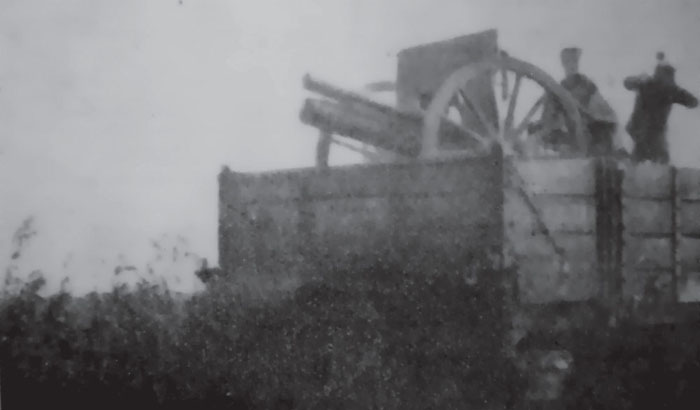
Austro-Hungarian wagon of an improvised armoured train of the UHA. This photo is of poor quality but interesting as it shows the exact moment of firing: the barrel of the 76.2mm field gun is seen at maximum recoil.
(Photo: Alexander Diedyk Collection via Krzysztof Margasinski)
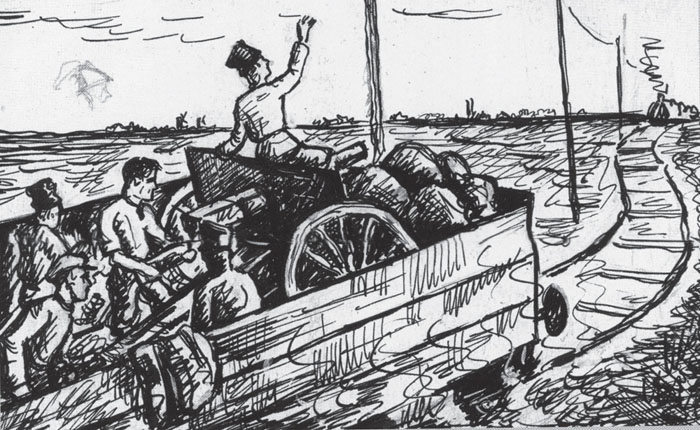
A woodcut showing a similar gun on a UHA train, fighting an oncoming Polish armoured train.
(Woodcut: Alexander Diedyk Collection via Krzysztof Margasinski)
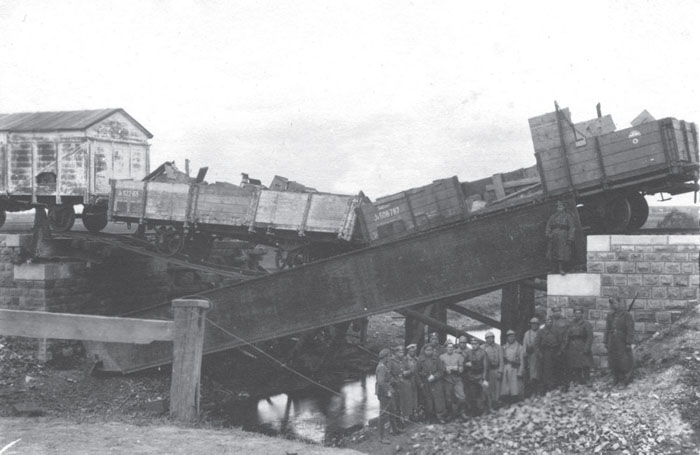
Armoured Train No 212 of I Corps of the UHA, halted and then captured by the Poles on 15 May 1919. Note the improvised protection consisting of trench shields fastened to the sides of the vans and wagons.
(Photo: Mariusz Zimny Collection)
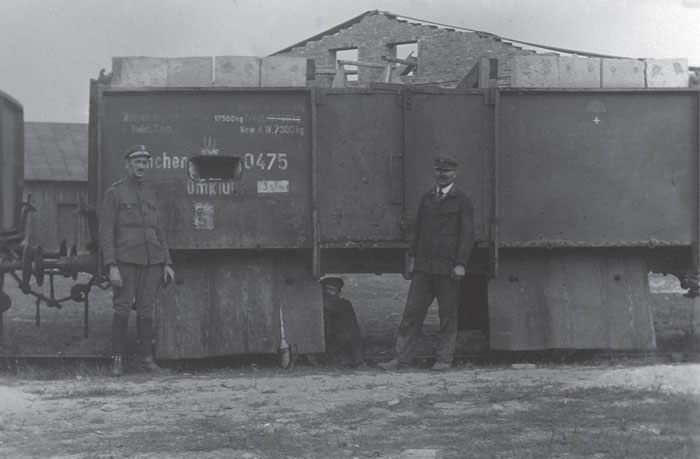
A view of a Ukrainian armoured train, converted from German Type Om high-sided wagons, captured by the Poles on 9 July 1919 near D uryn (Buczacz region) during the Polish-Ukrainian War. Note the thickness of the protection and the plates extending above the wagon sides, probably trench shields.
(Photo: CAW)
Despite its retreat behind the line of the Zbrucz, the UHA was not defeated. It regrouped in the Kamenets-Podolski region and formed three army corps. Along with about a hundred field guns and 390 machine guns, in late 1919 I Corps possessed an armoured train (Russian gauge), named Halatschina, which the UHA had captured during its offensive towards Kiev in August of that year.
On 23 June 1917, the National Ukrainian Republic6 was proclaimed. After the Russian Revolution, for a time it formed part of Russia. Several armoured trains were operated, and they ranged in quality from improvised wagons or units built in naval workshops such as in Odessa, to refined and well-armoured units captured from the Bolsheviks and Denikin’s White forces.
The train in the photo below began life as Russian Armoured Train No 1 Chunchuz, immobilised in No Man’s Land by hits from Austro-Hungarian artillery on 24 September 1915. After repairs, it was used by the Bolsheviks, then became Ukrainian Armoured Train Sichevik7 of the Petlioura Army. Captured by the Poles on 24 May 1920, it was used against the Russians under the name of Krechowiak – as in the photo below – then later as General Dowbór. Then on 6 June 1920, it changed hands for the last time, being captured by the Red Cossacks of Budenny’s First Cavalry Army. It appears to have suffered no serious damage, as its latest owners managed to repair it. It apparently remained in Russian service right up to the beginning of the Second World War.
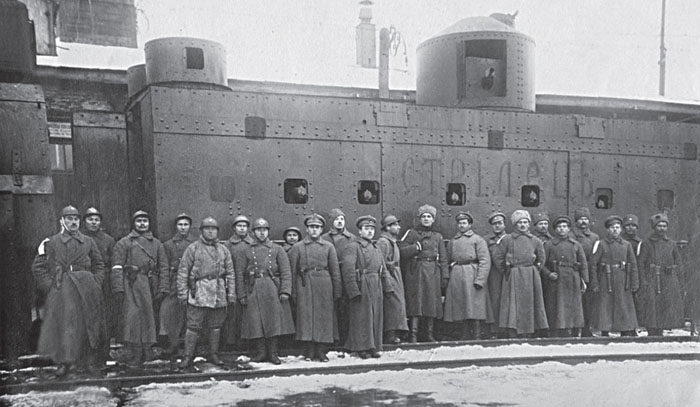
Armoured train captured from the Whites by the Sich Riflemen at Kiev and then renamed Sichovy Strilets. The inscription ‘ strilets’ (riflemen) can be made out on the wagon’s side. Note the fake firing slots painted in black to deceive enemy snipers.
(Photo: All Rights Reserved)
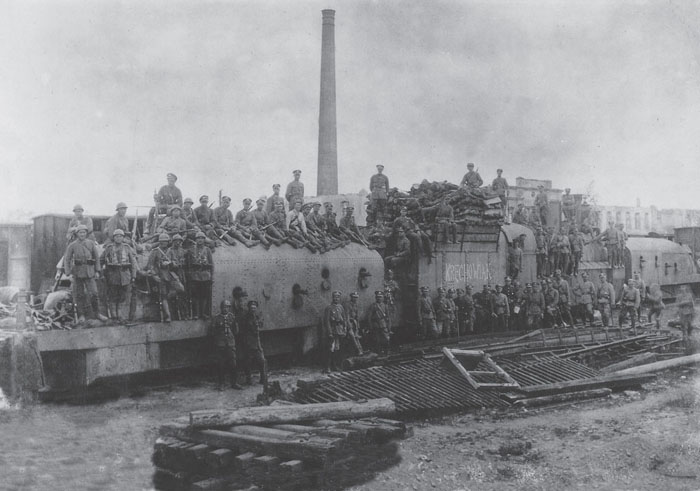
Armoured train Krechowiak seen in May 1920.
(Photo: CAW)
Captured following the action by Colonel Wolf at Schepietovka in August 1919, this is the train christened Wilna Ukraina (‘Free Ukraine’). The design of the train is the same as several examples built in the railway workshops in Kiev, powered by Class O steam engines, such as Communist Korosthenskovo Rayona (‘The Communists of the Korosten Region’) and Karl Liebknecht.
(Postcard: Paul Malmassari Collection)
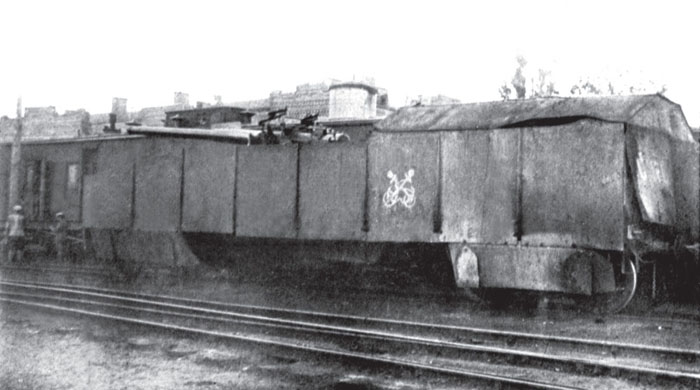
Bolshevik broad-gauge armoured train captured from the Petliura Army in 1919. Here its high-sided bogie wagon has been fitted with crude armour and a Canet naval gun.
(Photo: Krzysztof Margasiński Collection)
In the combat zone where the Polish forces and the Ukrainians of Petlioura operated side-by-side from April 1920, notably in Podolia,8 the railway network was dual gauge, both Russian broad gauge and European standard gauge.
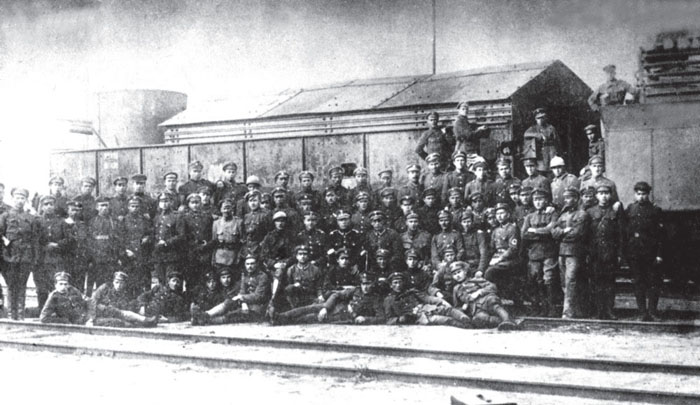
Russian broad-gauge Armoured Train Ukraine (note the inscription in Cyrillic and roman letters) seen in late 1920. The high-sided bogie wagon is fitted with a turret armed with a 76.2mm Model 1902 field gun.
(Photo: Krzysztof Margasiński Collection)
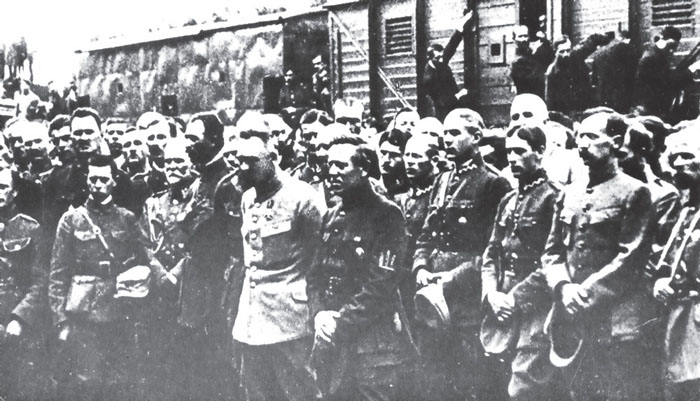
A meeting of two famous personalities, Józef Piłsudski of Poland and Symon Petliura of the Ukraine, at Stanislawow on 5 September 1920, on the occasion of the commissioning of the Ukrainian Armoured Train Кармелюк (Karmeluk), built in the local railway workshops.
(Photo: Krzysztof Margasiński Collection)
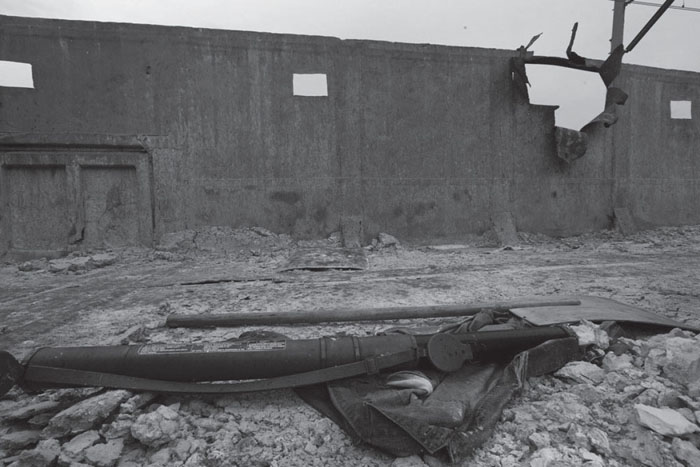
The Ukraine’s desire for closer ties with the European Union, as opposed to its traditional ties with Russia, saw the sporadic reappearance of attempts to build armoured trains, such as this high-sided bogie wagon with roughly-cut firing embrasures, emplaced as a roadblock in the Lugansk region. Note the damage from a shell or RPG.
(Photo: All Rights Reserved)
SOURCES:
Archives:
Polish Historical Service (CAW).
Books:
Krotofil, Maciej, Ukraińska Armia Halicka 1918-1920 (Toruń: Wydawnictwo ‘Adam Marszałek’, 2002).
Tynchenko, Yaroslav, Armored Trains and Armored cars in the War of Liberation 1917-1920 (Kiev: Tempora, 2012).
Journal articles:
Diedyk, Alexander G, ‘Armored Trains of the UHA. The war on railway tracks’, The Red Kalyna Chronicle No 6–7 (1992).
Wolos, Mariusz, ‘Sortir de la guerre à Lvov’, Revue historique des armées [online] 251 (2008), put online 9 June 2008, URL : http://rha.revues.org/323
Video:
Website:
http://www.encyclopediaofukraine.com/default.asp
1. Also known as the Ukrainian Army of Galicia – Ukrayins’ka Halyts’ka Armiya (UHA). It was the regular army of the Western Ukrainian National Republic – Zakhidnoukrayins’ka Narodna Respublyka (ZUNR). This army existed during and after the Polish-Ukrainian War.
2. It should also be noted that a Red armoured train named Ukrainski Revolutsija (‘Ukrainian Revolution’) was captured by the Finns near Antrea in late March 1918. This was obviously an honorific designation, as neither the train nor its crew had any connection with the Ukrainian Front.
3. 5 December 1918 – 23 January 1919.
4. Tributary of the Dniestr, in the western part of modern Ukraine, which marked the frontier between the former Austro-Hungarian and Russian Empires.
5. Today situated in the north-west of modern Moldavia.
6. Українська Народня Республіка (УНР), Ukrayins’ka Narodnia Respublika (UNR).
7. The name given to the members of the Sich Riflemen (derived from the term for a Cossack encampment).
8. A region which became Polish in 1919 after having formed part of the Western Ukrainian Republic. The Soviets briefly occupied it during the Russo-Polish War.